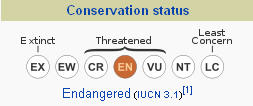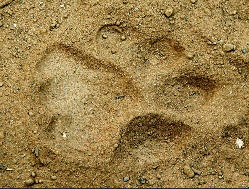Tiger (Panthera tigirs)
The tiger is the largest member of the felid (cat) family. They sport long, thick, reddish coats with white bellies and white and black tails. Their heads, bodies, tails and limbs have narrow black, brown or gray stripes. Three of the nine subspecies of tigers are now extinct.
Size
- Height: 3-3 1/2 ft. at shoulders
- Length: Head and body length, 4.6-9.2 ft. (tail length, 2-3 ft.)
- Weight: The Siberian tiger is the largest subspecies and males weigh from around 400-675 lbs, while the Sumatran tiger, the smallest living subspecies, weighs in from around 220-310 lbs. Females of all tiger subspecies are smaller than the males.
Lifespan
- 10-15 years in the wild
- About 20 years in captivity
Reproduction
- Mating Season: In tropical climates, mostly from around November-April; in temperate regions, during the winter months.
- Gestation: 103 days
- Litter Size: 3-4 cubs
- Cub Rearing: Cubs follow their mother out of the den at around 8 weeks and become independent at around 18 months of age. They leave their mothers at about 2 1/2 years. Mothers guard their young from wandering males that may kill the cubs to make the female receptive to mating.
Range
Diet
Behavior/Habitat
Tigers occupy a variety of habitats from tropical forests, evergreen forests, woodlands and mangrove swamps to grassland savannah and rocky country. They are mostly nocturnal and are ambush predators that rely on the camouflage their stripes provide. Tigers use their body weight to knock prey to the ground and kill with a bite to the neck. They are also very good swimmers and have been known to kill prey while swimming. Tigers essentially live solitary lives, except during mating season and when females bear young. They are usually fiercely territorial and have and mark their large home ranges.


Population/Status
In the early 1900s, there were around 100,000 tigers throughout their range. Today, an estimated total of around 5,000-7,000 exist in the wild.
Bengal (Panthera tigris tigris): 3000-4500 IUCN: Endangered CITES: Appendix I
Indochinese tiger (Panthera tigris corbetti): 700-1300 IUCN: Critically Endangered CITES: Appendix I
Siberian (Amur) tiger (Panthera tigris altaica): 430-530 IUCN: Critically Endangered CITES: Appendix I
Sumatran tiger (Panthera tigris sumatrae): less than 400 IUCN: Endangered CITES: Appendix I
Malayan tiger (Panthera tigris jacksoni): around 500 IUCN: Unclassified CITES: Appendix I
South China tiger (Panthera tigris amoyensis): perhaps a few IUCN: Critically Endangered CITES: Appendix I Thought by many scientists to be “functionally extinct.”
Caspian tiger (Panthera tigris virgata): extinct since the 1950s
Javan tiger (Panthera tigris sondaica): extinct since the 1970s
Bali tiger (Panthera tigris balica): extinct since the 1937
Threats
They are illegally killed or poached because their pelts are valuable in the black market trade, their body parts are used in traditional Asian medicines and they are seen as threats to human communities. There is also large scale habitat loss due to human population growth and expansion. Human encroachment into tiger habitat also decreases prey animals.
Interesting Facts
- Every tiger’s stripe pattern is unique.
- A ninth subspecies of tiger, the Malayan tiger, was identified in 2004.
- The white tiger and golden tabby are Bengal tigers, not separate subspecies. Although in captivity, they are primarily Bengal/Siberian cross.
- There are more tigers in captivity than in the wild.
- Tigers are successful only about 1 out of every 20 hunts. When they are successful, they will gorge themselves, consuming about 80 lbs of meat in one feeding.
- Tigers are essentially solitary and territorial animals.
- Like the other Panthera cats, tigers can roar. Tigers will roar for both aggressive and non-aggressive reasons. Other tiger vocal communications include moans, hisses, growls and chuffs.
- The tiger replaces the lion as King of the Beasts in cultures of eastern Asia,representing royalty, fearlessness and wrath.
- In a poll conducted by Animal Planet, the tiger was voted the world’s favourite animal, narrowly beating the dog.
- Just like the domestic housecat, tigers keep their claws sharp for hunting by pulling in their retractable claws into a protective sheath.
The world does not pay for what a person knows. But it pays for what a person does with what he knows.
~Laurence Lee

Primary Sources:
Defenders of Wildlife and WWF






